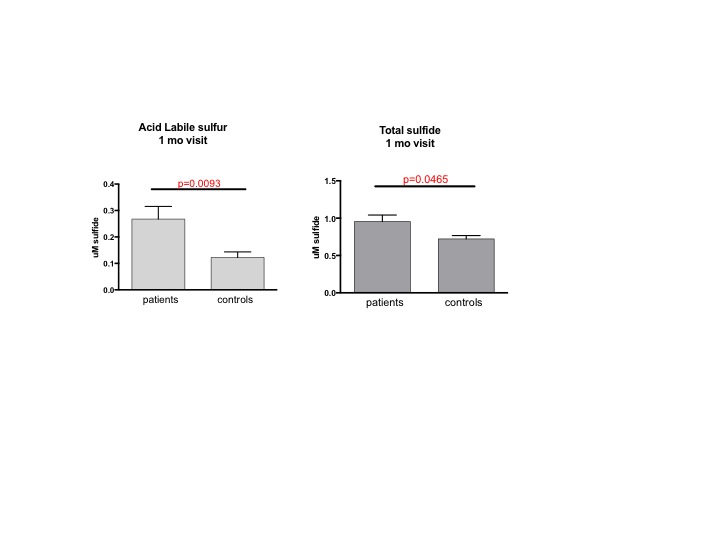Session Information
Date: Monday, November 6, 2017
Title: Rheumatoid Arthritis – Human Etiology and Pathogenesis Poster II
Session Type: ACR Poster Session B
Session Time: 9:00AM-11:00AM
Background/Purpose:
Hydrogen sulfide (H2S) is an endogenous gasotransmitter known to play a role in inflammation. While levels of hydrogen sulfide have been studied in patient populations with cardiovascular disease, there has been little research of H2S levels in plasma of subjects with autoimmune diseases such as rheumatoid arthritis (RA). H2S bioavailability is regulated through its conversion into different biochemical forms. Past H2S studies concerning rheumatoid arthritis have not employed analytical biochemistry to measure biochemical forms of H2S, specifically the free H2S, acid-labile sulfide, and bound sulfane sulfur. Thus, the aim of this study was to measure these metabolites of H2S in rheumatoid arthritis subjects and compare them to non-RA individuals over time.
Methods:
Thirty control non-RA and thirty RA subjects were selected based on specific criteria and consented in the University Health Rheumatology Clinic. Subjects with diabetes were excluded from the study. Following consent, 10 ml of venous blood was collected into a BD microtainer plasma separator tube with heparin. Samples were prepared for detecting H2S pools. Hydrogen sulfide can be released from acid-labile sulfide form in 100 mM phosphate buffer (pH 2.6) with or without the reductant TCEP. Sulfide levels were measured by derivatization of hydrogen sulfide with excess monobromobimane (MBB) in 50 mM Tris-HCl buffer. The fluorescent product sulfide-dibimane was then measured by RP-HPLC with a fluorescence detector. An F test was performed on the data to check for a significant difference in variances. Because the variances differed significantly with some populations, the Mann-Whitney test was performed.
Results:
Subjects with RA had significantly higher levels of acid labile sulfur (p=0.009) and total sulfide (p=0.04) at the one month blood draw. Additionally, acid labile sulfide levels (p=0.04) and total sulfide levels (p=0.01) were greater in control males as compared to females at the 6-month blood draw. White male control’s H2S levels were found to have an upward trend over the 6 months.
Conclusion:
This research serves as a pilot study comparing the different biochemical forms of H2S (free, acid-labile, and bound) in the plasma of RA subjects versus control subjects. The method used in this study is unique, validated and quantitative because, unlike any prior studies on H2S, the MBB method analytically measures different forms of H2S in the plasma. Our findings show that acid labile and total H2S levels are higher in RA subjects than controls at the one month visit. Further studies are needed to determine the relationship of medications, disease activity, and diet during various time points of disease progression.
To cite this abstract in AMA style:
Guice A, Dhawan R, Pardue S, Kevil C. Hydrogen Sulfide Metabolism and Rheumatoid Arthritis [abstract]. Arthritis Rheumatol. 2017; 69 (suppl 10). https://acrabstracts.org/abstract/hydrogen-sulfide-metabolism-and-rheumatoid-arthritis/. Accessed .« Back to 2017 ACR/ARHP Annual Meeting
ACR Meeting Abstracts - https://acrabstracts.org/abstract/hydrogen-sulfide-metabolism-and-rheumatoid-arthritis/

